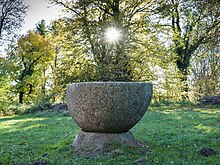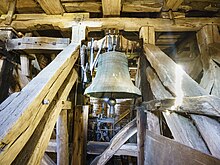Moisall village church
The Protestant village church Moisall is an early Gothic church in field stone and brick masonry in the Moisall district of Bernitt in the Rostock district in Mecklenburg-Western Pomerania . It belongs to the parish of Bernitt in the Rostock provost in the Güstrow parish of the Evangelical Lutheran Church in Northern Germany (Northern Church) .
History and architecture
The church in Moisall was first mentioned in a document in 1264. At that time, the Schwerin bishop Hermann named the Moisaller church opposite the Schlemminer chapel as the main church.
The Moisaller Church is a rectangular hall church from the end of the 13th century in field stone masonry with parts made of brick , which is laid out on a vault. A choir does not exist. The north sacristy with a neo-Gothic altered brick gable was probably built at the same time as the church. While the upward sloping base stones and the corner stones of the ship (but not the tower) are carefully worked, the field stones for the wall structure are partly split, but partly also unworked. The window reveals as well as the gable triangles of the nave are made of bricks. The ship was completed around 1300. Originally, the inner space of the Moisaller Church was to be spanned by two square vaults. However, this was not implemented. Only the vaults (shield arches and semicircular service templates ) were completed at that time.
The west tower, dated dendrochronologically to 1433d, has a square floor plan and is closed with a pyramid roof . There is a single-hand clock on the west tower. Around 1500 a porch made of field and brick with a screen gable was added to the south.
The church was rebuilt in the first half of the 18th century; the ship was covered with a mansard roof with a crooked hip over the trimmed eastern gable. The wooden barrel vault installed at that time was renewed during a restoration in 1895 together with the north sacristy. In the 18th century, the northern sacristy served as a hereditary burial for the von Rudloff family. When the church was renovated, the burial place was rebuilt into a sacristy and the coffins were buried in the ground. In 1997/98 restoration work was carried out on the tower clock.
On the west side of the church, in front of the tower, there is a Romanesque baptismal font from the 13th century, which is by far the oldest movable part of the entire complex. It wasn't put back in its original place until 2003.
Description and equipment
The Moisaller Church has been described several times. The first representation can be found in the yearbooks of the Association for Mecklenburg History and Archeology by Crull. The Moisaller Church is also described in the standard work "The Art and History Monuments of the Grand Duchy of Mecklenburg-Schwerin" by Schlie. Further individual and short descriptions can be found in various publications, including the art guide Dehio. A current presentation was published in 2011.
Ship and altar
The altarpiece is a work from 1726 and shows a painting with Christ next to three sleeping disciples in the garden of Gethsemane on the Mount of Olives , which is framed by columns and carved cheeks. The Renaissance pulpit is richly structured on the parapet with columns and is significantly older than the altarpiece and was built around 1615 (inscription). It is equipped with the coat of arms reliefs of those of von Wackerbarth , von Vieregge and von Bülow . A richly carved sound cover dates from the first half of the 18th century.
A box in plait style is from around 1802. A wooden coat of arms epitaph with architectural framing was made in 1788. A gallery with pilasters from 1726 carries the organ.
In the nave there are memorial plaques for the veterans and fallen soldiers of the wars of the 19th century.
organ
The organ with an early classical prospect with elements of the baroque was made by Carl Börger in 1912 and has five stops on a manual with attached pedal . A special feature is the cabinet, nor from the previous organ from Friedrich Friese I . dates from 1802. The case and organ were extensively renovated in 2016.
Bells
There are two bronze bells in the tower: the larger bell (diameter 1.15 meters) with the tone h 2 +7 was cast in 1551, the smaller bell (1.05 meters diameter) with the tone f 1 +3 is from 1625 and comes from a Wismar workshop and was cast by J. Gravert. It bears the inscription "PENTZIN 1813" that was subsequently applied.
literature
- Friedrich Crull : The church at Moisall. In: Yearbooks of the Association for Mecklenburg History and Archeology, Volume 27 (1862), pp. 208–210.
- Friedrich Schlie : The art and history monuments of the Grand Duchy of Mecklenburg-Schwerin. Bärensprung Hofbuchdruckerei, Schwerin, 1901 (especially Volume IV).
- Georg Dehio : Handbook of the German art monuments. Mecklenburg-Western Pomerania. 2nd Edition. Deutscher Kunstverlag, Berlin / Munich 2016, ISBN 978-3-422-03128-9 , pp. 376–377.
- Steffen Daebeler: From the sacrificial stone to the Katharinenglocke - Bernitt and surroundings - pictures and times. (Ed .: Kirchgemeinde Bernitt), Bernitt 2011.
- Tilo Schöfbeck: Medieval churches between Trave and Peene. Lukas Verlag for Art and Intellectual History, 2014.
Web links
- Literature about the village church Moisall in the state bibliography MV
- Association Church animated eV of the parish of Bernitt
- Friedrich Crull: The church at Moisall
Individual evidence
- ↑ Schöfbeck, 2014
- ^ Crull, 1862
- ↑ Daebeler, 2011
- ↑ Information about the organ on the website of the Malchow Organ Museum. Retrieved December 26, 2017 .
Coordinates: 53 ° 52 '56.1 " N , 11 ° 50' 14.9" E







